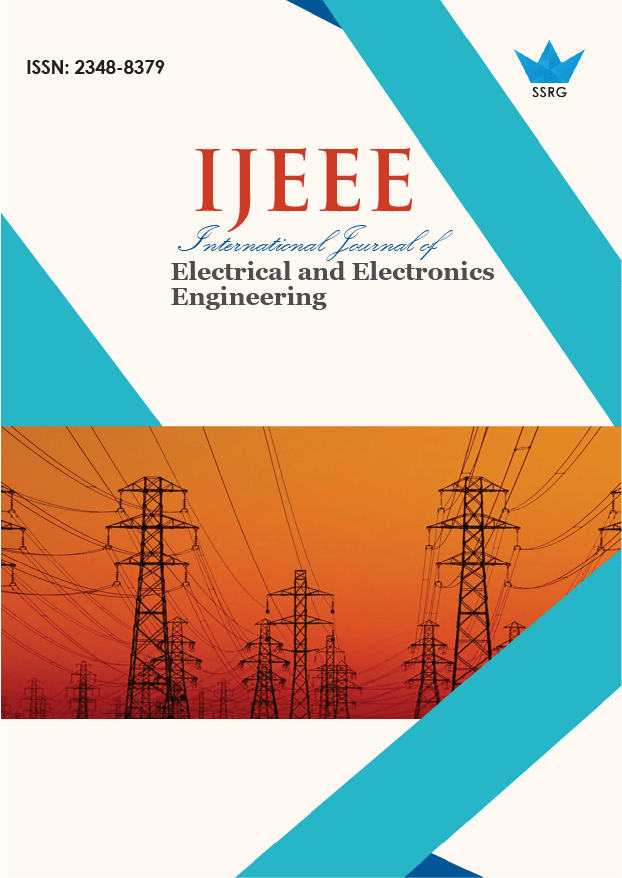Faults Identification and Classification in Power Systems Using Integrated Wavelet Transform and RBFNN Approach

| International Journal of Electrical and Electronics Engineering |
| © 2025 by SSRG - IJEEE Journal |
| Volume 12 Issue 6 |
| Year of Publication : 2025 |
| Authors : Nurhalim, Kalimah Sakti Rinjani, Suwitno, Iswadi Hasyim Rosma, Amir Hamzah |
How to Cite?
Nurhalim, Kalimah Sakti Rinjani, Suwitno, Iswadi Hasyim Rosma, Amir Hamzah, "Faults Identification and Classification in Power Systems Using Integrated Wavelet Transform and RBFNN Approach," SSRG International Journal of Electrical and Electronics Engineering, vol. 12, no. 6, pp. 136-145, 2025. Crossref, https://doi.org/10.14445/23488379/IJEEE-V12I6P111
Abstract:
This research presents an integrated Wavelet Transform and RBFNN approach for identifying and classifying power system faults. The RBFNN is trained to output values corresponding to specific fault classes based on WT-derived features, where a predicted value near 1 indicates a fault on a particular phase or Ground, and a value near 0 indicates no fault. The novelty of this work lies in the application of RBFNN with these features, aiming for improved performance over common Artificial Neural Network approaches. Various short-circuit faults were simulated on an IEEE 30-bus system using PSCAD. Fault parameters like location and resistance were varied to create 2541 scenarios. Discrete Wavelet Transform extracted features from phase and ground currents, comparing Daubechies 4 (dB4) and Symlet4 (sym4) wavelets at decomposition levels 1, 2, and 3. The RBFNN was trained with 90% of the data and tested on the remaining 10%. The outputs of the RBFNN are continuous values intended to approximate these binary (0 or 1) targets, and their proximity is measured by Mean Squared Error (MSE). Results showed that the dB4 wavelet at decomposition level 3 provided the best performance, achieving MSE values below the 10−5 threshold for all phases (Phase A: 4.59621×10−8, Phase C: 2.7304×10−8). These low MSE values indicate high accuracy in the RBFNN's output regressing to the target binary vectors, thereby effectively classifying the fault types. This approach showcases an effective technique for identifying faults and then categorizing them.
Keywords:
Transmission lines, Radial basis function Neural network, Signal processing, Wavelet transformation, PSCAD.
References:
[1] Syafriyudin Syafriyudin, Electrical Power Transmission, AKPRIND PRESS, Yogyakarta Institute of Science & Technology, 2012.
[Google Scholar] [Publisher Link]
[2] Komang Jaryanta Aryamantara, I.A.D. Giriantari, and I.W. Sukerayasa, “Short Circuit Analysis on 20 kV Medium Voltage Network of Kedonganan Feeder,” Scientific Journal of Electrical Technology, vol. 17, no. 2, pp. 213-220, 2018.
[CrossRef] [Publisher Link]
[3] M.J. Reddy, and D.K. Mohanta, “Adaptive-Neuro-Fuzzy Inference System Approach for Transmission Line Fault Classification and Location Incorporating Effects of Power Swings,” IET Generation, Transmission and Distribution, vol. 2, no. 2, pp. 235-244, 2008.
[CrossRef] [Google Scholar] [Publisher Link]
[4] B.M. Weedy et al., Electric Power Systems, 5th ed., Chichester, West Sussex, United Kingdom: John Wiley and Sons, Inc., 2012.
[Google Scholar] [Publisher Link]
[5] Md. Sihab Uddin et al., “On the Protection of Power System: Transmission Line Fault Analysis Based on an Optimal Machine Learning Approach,” Energy Reports, vol. 8, pp. 10168-10182, 2022.
[CrossRef] [Google Scholar] [Publisher Link]
[6] Kunjin Chen, Caowei Huang, and Jinliang He, “Fault Detection, Classification and Location for Transmission Lines and Distribution Systems: A Review on the Methods,” High Voltage, vol. 1, no. 1, pp. 25-33, 2016.
[CrossRef] [Google Scholar] [Publisher Link]
[7] A. Abdollahi, and S. Seyedtabaii, “Comparison of Fourier & Wavelet Transform Methods For Transmission Line Fault Classification,” 2010 4th International Power Engineering and Optimization Conference (PEOCO), Shah Alam, Malaysia, pp. 579-584, 2010.
[CrossRef] [Google Scholar] [Publisher Link]
[8] Tamer S. Abdelgayed, Walid G. Morsi, and Tarlochan S. Sidhu, “A New Approach for Fault Classification in Microgrids Using Optimal Wavelet Functions Matching Pursuit,” IEEE Transactions on Smart Grid, vol. 9, no. 5, pp. 4838-4846, 2018.
[CrossRef] [Google Scholar] [Publisher Link]
[9] Md. Chayon Ali, and Bristy Sinha, Faults Detection and Classification of Transmission Lines in Power System using Wavelet Transform, Bachelor Thesis, Department of Electrical and Electronics Engineering, International University of Business Agriculture and Technology, Dhaka, Bangladesh, 2023. [Online]. Available: https://www.researchgate.net/publication/383523768_Faults_Detection_and_Classification_of_Transmission_Lines_in_Power_System_using_Wavelet_Transform#:~:text=This%20thesis%20proposes%20a%20methodology,provide%20excellent%20time%2Dfrequency%20resolution.
[10] Abel Aditya Aryaguna, Dimas Okky Anggriawan, and Suhariningsih Suhariningsih, “Identifying Types of Disturbances in Electrical Distribution Networks Using Artificial Neural Networks,” Inovtek Journal Electric Series, vol. 3, no. 1, pp. 27-35, 2021.
[Publisher Link]
[11] Prashanth Neelugonda, and K. Srinivas, “Radial Basis Function Neural Network with Wavelet Transform for Power System Fault Identification and Classification,” 2nd Indian International Conference on Industrial Engineering and Operations Management, Warangal, Telangana, India, pp. 1194-1202, 2022.
[CrossRef] [Google Scholar] [Publisher Link]
[12] Bharathwaaj Sundararaman, and Prateek Jain, “Fault Detection and Classification in Electrical Power Transmission System Using Wavelet Transform,” Engineering Proceedings, vol. 59, no. 1, pp. 1-8, 2023.
[CrossRef] [Google Scholar] [Publisher Link]

 10.14445/23488379/IJEEE-V12I6P111
10.14445/23488379/IJEEE-V12I6P111